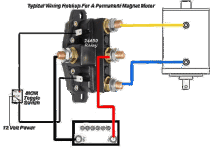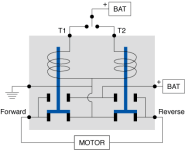matt_unique
New member
Napoleon is back in the water and looking great! During my shakedown cruise for this season I noticed when I engaged the windlass, with engines running, it would drop my voltage to the point where it would reset my GPS/Radar system (this has never happened before).
Using a multimeter I checked the voltage at the applicable bats. With engines off my house reads 12.49 volts, stb start bat reads the same, and the port start reads 12.6 volts. Of course only the house and stb start powers my windlass and electronics (I always have my stb bat switch set to 'Both' with engines running).
I have a paper schematic of the back of my windlass switch. The leads on the side are DC 'in' and the leads at the bottom of the switch are DC 'out' leading to the windlass. I checked the voltage on the DC 'in' leads on the windlass switch and the loss is only .09 volts from the bat. I tested the loss at the DC 'in' leads on my main fuse panel behind the helm and it reads a bit more of a drop - .14. Said another way, the wiring leading to my windlass switch is more efficient than the wiring leading to my main fuse panel. That to me rules out problems from my bat to the windlass switch.
With engines running - the DC 'in' on the windlass switch reads 14.43 volts. With the windlass engaged, the DC out on the windlass switch reads 11.72 volts. I don't know if that is within the correct parameters.
Based on what I think I know so far - by all means chime in and correct me if I'm mistaken - the problem is either the switch itself (perhaps someone else knows the acceptable voltage drop with switch engaged?), the wiring leading from the switch to the windlass, the wiring contacts on the windlass, or the windlass itself. There must be some corrosion or a loose contact between the switch and the windlass leading to high resistance.
Thanks for the suggestions.
--Matt
Using a multimeter I checked the voltage at the applicable bats. With engines off my house reads 12.49 volts, stb start bat reads the same, and the port start reads 12.6 volts. Of course only the house and stb start powers my windlass and electronics (I always have my stb bat switch set to 'Both' with engines running).
I have a paper schematic of the back of my windlass switch. The leads on the side are DC 'in' and the leads at the bottom of the switch are DC 'out' leading to the windlass. I checked the voltage on the DC 'in' leads on the windlass switch and the loss is only .09 volts from the bat. I tested the loss at the DC 'in' leads on my main fuse panel behind the helm and it reads a bit more of a drop - .14. Said another way, the wiring leading to my windlass switch is more efficient than the wiring leading to my main fuse panel. That to me rules out problems from my bat to the windlass switch.
With engines running - the DC 'in' on the windlass switch reads 14.43 volts. With the windlass engaged, the DC out on the windlass switch reads 11.72 volts. I don't know if that is within the correct parameters.
Based on what I think I know so far - by all means chime in and correct me if I'm mistaken - the problem is either the switch itself (perhaps someone else knows the acceptable voltage drop with switch engaged?), the wiring leading from the switch to the windlass, the wiring contacts on the windlass, or the windlass itself. There must be some corrosion or a loose contact between the switch and the windlass leading to high resistance.
Thanks for the suggestions.
--Matt


